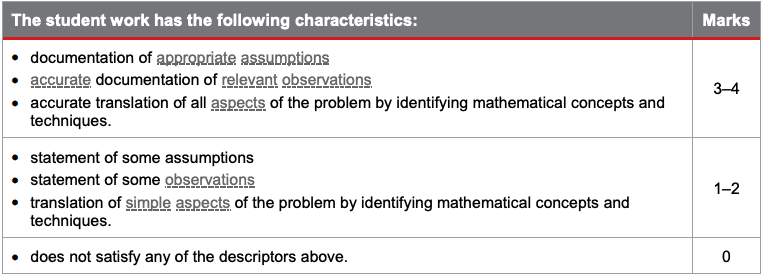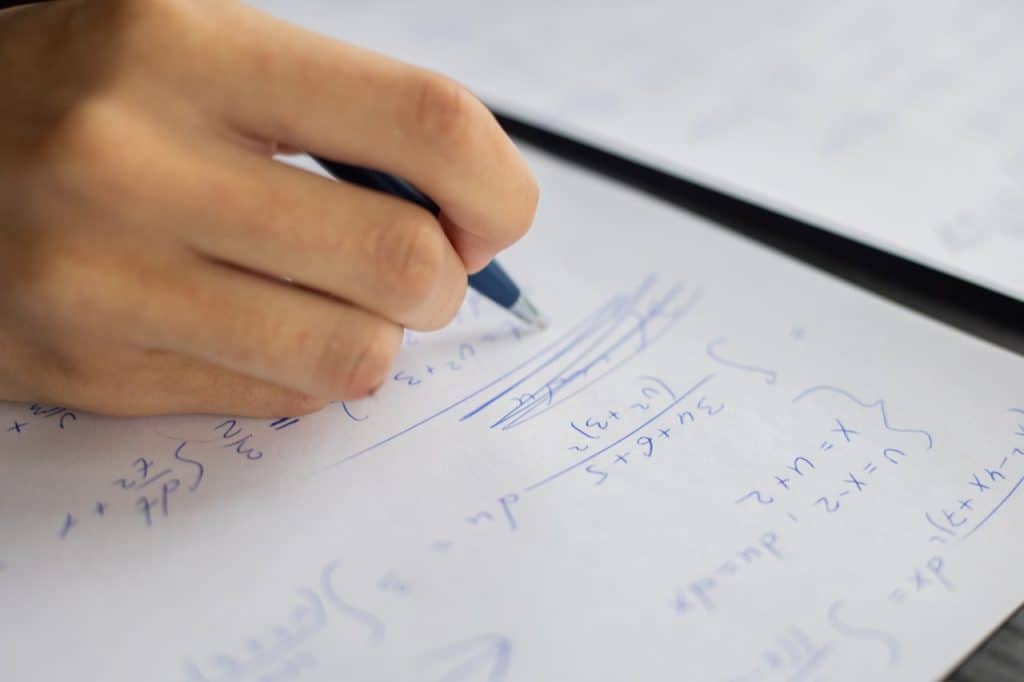Achieving an A in QCAA Maths Methods is not a simple task — you need to work at it, manage your time well and stay motivated when concepts don’t click.
But that doesn’t mean you’re not going to get through it!
First things first, you need to figure out if you’re in the right level for QCAA Maths or need to drop. Don’t skip this step!
Then, whether you’re concerned about how to study for the External Exam, or how to structure the PSMT, I have some tips, tricks, and things to consider that will help you achieve your very best.
Scroll down to find out more!
IA1: Problem-Solving and Modelling Task (PSMT)
IA2: Unit 3 Internal Examination
IA3: Unit 4 Internal Examination
EA: The External Exam
IA1: Problem-Solving and Modelling Task (PSMT)
The PSMT is the first of your summative internal assessments. It is written by your teachers and can take place either late Term 4 Year 11 or Term 1 Year 12 depending on your school.
It is an assessment task designed to evaluate your ability to respond to an investigative mathematical scenario or stimulus related to the mathematical concepts and techniques you have been learning in class.
Ultimately, you will respond to the task through a written report of under 2000 words. The key features of this report include providing a response that addresses the real-life application of mathematics, using technology, using tables/graphs/diagrams, and following the structure of a report.
The PSMT is worth 20% — the second most heavily weighted assessment piece you will do in QCAA Maths Methods. So, it’s not a bad idea to really try your best with it.
It’s also the only assignment you will do in QCAA Maths Methods, so if you’re someone who struggles with exams or generally does better with assignments, this is your chance to shine!
Searching for a Maths tutor in the Gold Coast? Learn about our holistic tutoring here!
How can you best prepare for the QCAA Maths Methods PSMT?
The most helpful tool for writing the PSMT is the Instrument-Specific Marking Guide (ISMG). The ISMG is split into four distinct criteria: Formulate, Solve, Evaluate and Verify, and Communicate.
The dot points included in each criterion can act as a checklist to help you know what to cover. For examples, see the criteria for the Formulate section of the ISMG below.
Many students try to take advantage of the PSMT as the only assignment in QCAA Maths Methods to bank as many marks as possible. Exams can be harder to prepare for, whereas with the PSMT, the structure and task is relatively clear.
The main thing to ensure is that you’ve considered and addressed all aspects of the task, i.e., you’ve considered all observations, assumptions, strengths, limitations, as well as reasonableness of your solution.
It’s a good idea to experiment with different designs/models before choosing one, and to have a backup model if things go wrong. Also, it’s okay if your design/model is not perfect, you can talk about its limitations in the evaluation section.
If you’re looking for in-depth guide to writing your PSMT, check out How to Structure Your PSMT Report for QCAA Mathematical Methods!
IA2: Unit 3 Internal Examination
The Unit 3 Internal Examination is a 120-minute exam that covers all the topics you have learned in Unit 3. It’s worth 15% of your overall grade and, like all QCAA Maths Methods exams, is split into a technology-free and technology active paper.
Unit 3 contains three topics:
- The logarithmic function 2
- Further differentiation and applications 2
- Integrals
These topics cover 8 sub-topics, which is quite a number of concepts, formulas, and applications to cover.
How can you best prepare for the Unit 3 Internal Examination?
The biggest tip for acing this exam is to find a way to integrate revision into your study time. Revising consistently will help you consolidate your knowledge and make links between concepts. It also means that you don’t have to revise as intensely when it gets close to the exam.
Questions on this exam are split into simple familiar, complex familiar, and complex unfamiliar types. Understanding the prevalence and degree of knowledge and application required for each of the different question types is essential.
Doing some extra complex familiar and complex unfamiliar will never go to waste; even though you might not get the exact same type of questions on the exam, you might be required to apply your knowledge in a similar way.
Finally, getting well acquainted with the resources you’ll have during this exam (i.e. your graphics calculator and formula booklet) will also be super helpful.
As half of the exam is technology active, understanding the functions of your calculator and how to access them quickly will save a lot of time and hassle. In a similar way, knowing where each formula is in the formula booklet and when/how to apply them will also save a lot of stress.
For some IA2 practice questions, see QCAA Unit 3 Maths Methods IA2 – Short Answer Practice Questions!
IA3: Unit 4 Internal Examination
IA3 is exactly the same format as IA2: a 120-minute exam with a technology-free and a technology-active paper that is worth 15% of your overall grade.
The only real difference is the content that is covered. IA3 will cover Unit 4, which contains 5 topics and 8 sub-topics.
Want to take a quick overview of what Unit 4 of Maths Methods looks like? Give this article a read!
The five topics covered are:
- Further differentiation and applications 3
- Trigonometric functions 2
- Discrete random variables 2
- Continuous random variables and the normal distribution
- Interval estimates for proportions
Usually, by the time you sit IA3, not all of Unit 4 would have been covered, which means you may be tested on less content than IA2. Regardless, it will still take time and effort to conquer this exam.
The only other thing to consider with this exam is how much more calculator dependent many of the questions are, specifically the probability questions. Therefore, knowing how to use your calculator is even more crucial for this exam!
For some IA3 practice questions, check out QCAA Unit 4 Maths Methods IA3 – Short Answer Practice Questions
If you want to know how your marks are tracking across all of your Maths Methods IA, check out our QCE Cohort Comparison Tool!
EA: The External Exam
The final hurdle! The External Exam is worth a considerable 50% of your final grade, so it will have a huge impact on it.
This can be super stressful to think about, but with the right preparation, you might even see it as a great opportunity to show off everything you know as opposed to a big scary exam!
How can you best prepare for the External Exam?
As the exam can cover any and all content from Units 3 and 4, leaving revision till a few weeks before the exam just won’t work. Similar to IA2 and IA3, the key to acing the External Exam is to integrate revision time into your study routine!
Making the most of the mock exams is also quite important. Not necessarily for the questions themselves (mock exams are somewhat notorious for having different questions to the actual exam), but to gain an understanding of what it will be like on the actual exam day.
If you know what to expect going into the exam, this will reduce a lot of the stress. Usually, the most stressful part of exams is not knowing what to expect, so if you at least know what it will be like in terms of timing, environment etc. all you have to worry about is the actual questions on the paper.
It’s also generally a good idea to bag as many marks as you can for your internal assessment. As your internal assessments are written by your teachers, you’ll have much more support in terms of guided revision and structure that won’t be there during your External Exam.
Make the most of this guidance and put in maximum effort for your internals as your External Exam can be much more unpredictable and can’t necessarily be ‘relied on’ to boost your Methods mark.
For many more tips on how to ace your Methods External Exam, check out How to Ace Your External Assessment for Mathematical Methods
If you’re after practice questions or practice tests for the External Exam, check out some below:
- Download QCAA Maths Methods Practice Exam for External Assessment Revision
- QCAA Practice Questions for Unit 3 & 4 Maths Methods External Assessment
- Multiple Choice Practice Questions for Maths Methods External Assessment
- Download QCAA Maths Methods Practice Exam for External Assessment Revision
- The Ultimate Guide to QCAA Maths Methods Unit 3: Further Calculus
- The Ultimate Guide to QCAA Maths Methods Unit 4: Further Functions and Statistics
Are you looking for some extra help with revising for QCAA Maths Methods?
We have an incredible team of QCE Maths Methods tutors and mentors!
We can help you master the QCAA Maths Methods syllabus and ace your upcoming Maths Methods assessments with personalised lessons conducted one-on-one in your home or online!
Looking for a Maths tutor in Brisbane? Learn about Art of Smart’s holistic tutoring here!
We’ve supported over 8,000 students over the last 11 years, and on average our students score mark improvements of over 20%!
One-on-one Gold Coast Maths tutoring is available now!
To find out more and get started with an inspirational QCE tutor and mentor, get in touch today or give us a ring on 1300 267 888!
Yalindi Binduhewa is an Art of Smart tutor based in Queensland and was part of the very first cohort to go through the ATAR system, so she knows exactly how fun and enjoyable it can be. She is currently studying a Bachelor of Medical Imaging (Honours) at QUT and is loving it. When she’s not doing uni-related stuff or tutoring, she’s hanging out with her friends, rewatching a show for the 100th time, or trying out new crafty projects and discovering that she doesn’t have a talent for everything.








